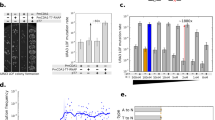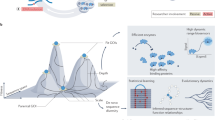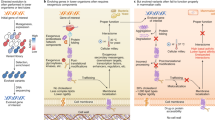Abstract
Engineering and study of protein function by directed evolution has been limited by the technical requirement to use global mutagenesis or introduce DNA libraries. Here, we develop CRISPR-X, a strategy to repurpose the somatic hypermutation machinery for protein engineering in situ. Using catalytically inactive dCas9 to recruit variants of cytidine deaminase (AID) with MS2-modified sgRNAs, we can specifically mutagenize endogenous targets with limited off-target damage. This generates diverse libraries of localized point mutations and can target multiple genomic locations simultaneously. We mutagenize GFP and select for spectrum-shifted variants, including EGFP. Additionally, we mutate the target of the cancer therapeutic bortezomib, PSMB5, and identify known and novel mutations that confer bortezomib resistance. Finally, using a hyperactive AID variant, we mutagenize loci both upstream and downstream of transcriptional start sites. These experiments illustrate a powerful approach to create complex libraries of genetic variants in native context, which is broadly applicable to investigate and improve protein function.
This is a preview of subscription content, access via your institution
Access options
Subscribe to this journal
Receive 12 print issues and online access
$259.00 per year
only $21.58 per issue
Buy this article
- Purchase on Springer Link
- Instant access to full article PDF
Prices may be subject to local taxes which are calculated during checkout




Similar content being viewed by others
References
Doerner, A., Rhiel, L., Zielonka, S. & Kolmar, H. Therapeutic antibody engineering by high efficiency cell screening. FEBS Lett. 588, 278–287 (2014).
Bornscheuer, U.T. et al. Engineering the third wave of biocatalysis. Nature 485, 185–194 (2012).
Soskine, M. & Tawfik, D.S. Mutational effects and the evolution of new protein functions. Nat. Rev. Genet. 11, 572–582 (2010).
Lienert, F., Lohmueller, J.J., Garg, A. & Silver, P.A. Synthetic biology in mammalian cells: next generation research tools and therapeutics. Nat. Rev. Mol. Cell Biol. 15, 95–107 (2014).
Hoogenboom, H.R. Selecting and screening recombinant antibody libraries. Nat. Biotechnol. 23, 1105–1116 (2005).
Liu, W., Brock, A., Chen, S., Chen, S. & Schultz, P.G. Genetic incorporation of unnatural amino acids into proteins in mammalian cells. Nat. Methods 4, 239–244 (2007).
Odegard, V.H. & Schatz, D.G. Targeting of somatic hypermutation. Nat. Rev. Immunol. 6, 573–583 (2006).
Di Noia, J.M. & Neuberger, M.S. Molecular mechanisms of antibody somatic hypermutation. Annu. Rev. Biochem. 76, 1–22 (2007).
Rajewsky, K., Förster, I. & Cumano, A. Evolutionary and somatic selection of the antibody repertoire in the mouse. Science 238, 1088–1094 (1987).
Yeap, L.S. et al. Sequence-intrinsic mechanisms that target AID mutational outcomes on antibody genes. Cell 163, 1124–1137 (2015).
Chaudhuri, J. et al. Transcription-targeted DNA deamination by the AID antibody diversification enzyme. Nature 422, 726–730 (2003).
Yu, K., Huang, F.T. & Lieber, M.R. DNA substrate length and surrounding sequence affect the activation-induced deaminase activity at cytidine. J. Biol. Chem. 279, 6496–6500 (2004).
Arakawa, H. et al. Protein evolution by hypermutation and selection in the B cell line DT40. Nucleic Acids Res. 36, e1 (2008).
Wang, L., Jackson, W.C., Steinbach, P.A. & Tsien, R.Y. Evolution of new nonantibody proteins via iterative somatic hypermutation. Proc. Natl. Acad. Sci. USA 101, 16745–16749 (2004).
Bowers, P.M. et al. Coupling mammalian cell surface display with somatic hypermutation for the discovery and maturation of human antibodies. Proc. Natl. Acad. Sci. USA 108, 20455–20460 (2011).
Küppers, R., Klein, U., Hansmann, M.L. & Rajewsky, K. Cellular origin of human B-cell lymphomas. N. Engl. J. Med. 341, 1520–1529 (1999).
Unniraman, S. & Schatz, D.G. AID and Igh switch region-Myc chromosomal translocations. DNA Repair (Amst.) 5, 1259–1264 (2006).
Chavez, A. et al. Highly efficient Cas9-mediated transcriptional programming. Nat. Methods 12, 326–328 (2015).
Gilbert, L.A. et al. Genome-scale CRISPR-mediated control of gene repression and activation. Cell 159, 647–661 (2014).
Qi, L.S. et al. Repurposing CRISPR as an RNA-guided platform for sequence-specific control of gene expression. Cell 152, 1173–1183 (2013).
Konermann, S. et al. Genome-scale transcriptional activation by an engineered CRISPR-Cas9 complex. Nature 517, 583–588 (2015).
Chen, B. et al. Dynamic imaging of genomic loci in living human cells by an optimized CRISPR/Cas system. Cell 155, 1479–1491 (2013).
Ma, H. et al. Multiplexed labeling of genomic loci with dCas9 and engineered sgRNAs using CRISPRainbow. Nat. Biotechnol. 34, 528–530 (2016).
Komor, A.C., Kim, Y.B., Packer, M.S., Zuris, J.A. & Liu, D.R. Programmable editing of a target base in genomic DNA without double-stranded DNA cleavage. Nature 533, 420–424 (2016).
Kearns, N.A. et al. Functional annotation of native enhancers with a Cas9-histone demethylase fusion. Nat. Methods 12, 401–403 (2015).
Tsai, S.Q. et al. Dimeric CRISPR RNA-guided FokI nucleases for highly specific genome editing. Nat. Biotechnol. 32, 569–576 (2014).
Nishida, K. et al. Targeted nucleotide editing using hybrid prokaryotic and vertebrate adaptive immune systems. Science 353, aaf8729 (2016).
Canver, M.C. et al. BCL11A enhancer dissection by Cas9-mediated in situ saturating mutagenesis. Nature 527, 192–197 (2015).
Mali, P. et al. RNA-guided human genome engineering via Cas9. Science 339, 823–826 (2013).
Cong, L. et al. Multiplex genome engineering using CRISPR/Cas systems. Science 339, 819–823 (2013).
Jinek, M. et al. A programmable dual-RNA-guided DNA endonuclease in adaptive bacterial immunity. Science 337, 816–821 (2012).
Ryan, O.W. et al. Selection of chromosomal DNA libraries using a multiplex CRISPR system. eLife 3, (2014).
Findlay, G.M., Boyle, E.A., Hause, R.J., Klein, J.C. & Shendure, J. Saturation editing of genomic regions by multiplex homology-directed repair. Nature 513, 120–123 (2014).
Cormack, B.P., Valdivia, R.H. & Falkow, S. FACS-optimized mutants of the green fluorescent protein (GFP). Gene 173, 33–38 (1996).
Tsien, R.Y. The green fluorescent protein. Annu. Rev. Biochem. 67, 509–544 (1998).
Heim, R., Cubitt, A.B. & Tsien, R.Y. Improved green fluorescence. Nature 373, 663–664 (1995).
Holohan, C., Van Schaeybroeck, S., Longley, D.B. & Johnston, P.G. Cancer drug resistance: an evolving paradigm. Nat. Rev. Cancer 13, 714–726 (2013).
Hideshima, T. et al. The proteasome inhibitor PS-341 inhibits growth, induces apoptosis, and overcomes drug resistance in human multiple myeloma cells. Cancer Res. 61, 3071–3076 (2001).
Lü, S. & Wang, J. The resistance mechanisms of proteasome inhibitor bortezomib. Biomark. Res. 1, 13 (2013).
Wang, M., Yang, Z., Rada, C. & Neuberger, M.S. AID upmutants isolated using a high-throughput screen highlight the immunity/cancer balance limiting DNA deaminase activity. Nat. Struct. Mol. Biol. 16, 769–776 (2009).
Lü, S. et al. Different mutants of PSMB5 confer varying bortezomib resistance in T lymphoblastic lymphoma/leukemia cells derived from the Jurkat cell line. Exp. Hematol. 37, 831–837 (2009).
Cancer Genome Atlas Network. Comprehensive molecular characterization of human colon and rectal cancer. Nature 487, 330–337 (2012).
Rajagopal, N. et al. High-throughput mapping of regulatory DNA. Nat. Biotechnol. 34, 167–174 (2016).
Korkmaz, G. et al. Functional genetic screens for enhancer elements in the human genome using CRISPR-Cas9. Nat. Biotechnol. 34, 192–198 (2016).
Wang, T., Wei, J.J., Sabatini, D.M. & Lander, E.S. Genetic screens in human cells using the CRISPR-Cas9 system. Science 343, 80–84 (2014).
McCulloch, S.D. & Kunkel, T.A. The fidelity of DNA synthesis by eukaryotic replicative and translesion synthesis polymerases. Cell Res. 18, 148–161 (2008).
Blagodatski, A. et al. A cis-acting diversification activator both necessary and sufficient for AID-mediated hypermutation. PLoS Genet. 5, e1000332 (2009).
Deans, R.M. et al. Parallel shRNA and CRISPR-Cas9 screens enable antiviral drug target identification. Nat. Chem. Biol. 12, 361–366 (2016).
Hendel, A. et al. Chemically modified guide RNAs enhance CRISPR-Cas genome editing in human primary cells. Nat. Biotechnol. 33, 985–989 (2015).
Martin, M. Cutadapt removes adapter sequences from high-throughput sequencing reads. EMBnet.journal 17, 10–12 (2011).
Li, H. & Durbin, R. Fast and accurate short read alignment with Burrows–Wheeler transform. Bioinformatics 25, 1754–1760 (2009).
Li, H. et al. The Sequence Alignment/Map format and SAMtools. Bioinformatics 25, 2078–2079 (2009).
Montague, T.G., Cruz, J.M., Gagnon, J.A., Church, G.M. & Valen, E. CHOPCHOP: a CRISPR/Cas9 and TALEN web tool for genome editing. Nucleic Acids Res. 42, W401–W407 (2014).
Bassik, M.C. et al. A systematic mammalian genetic interaction map reveals pathways underlying ricin susceptibility. Cell 152, 909–922 (2013).
Bassik, M.C. et al. Rapid creation and quantitative monitoring of high coverage shRNA libraries. Nat. Methods 6, 443–445 (2009).
Kampmann, M., Bassik, M.C. & Weissman, J.S. Integrated platform for genome-wide screening and construction of high-density genetic interaction maps in mammalian cells. Proc. Natl. Acad. Sci. USA 110, E2317–E2326 (2013).
Acknowledgements
We thank J. Sage, A. Brunet, A. Fire, and members of the Bassik lab for critical reading of the manuscript and helpful discussions. We thank J. Sollier and the Cimprich lab (Stanford University) for the FLAG-AID plasmid, and A. Sockell for help with sequencing. We thank O. Ursu, D. Morgens, C. Araya, E. Boyle, and A. Kundaje for their design of safe-targeting sgRNAs. Cell sorting and flow cytometry analysis was performed on an instrument in the Stanford Shared FACS Facility obtained using NIH S10 Shared Instrument Grant (S10RR025518-01). This work was funded by NIH T32HG000044 (G.T.H.), CEHG Fellowship (L.F.), the Walter V. and Idun Berry postdoctoral fellowship (K.H.), NSF DGE-114747 (C.H.L.), NIH ES016486 (K.A.C.), NIH R01HG008150 (S.B.M. and M.C.B.), and NIH 1DP2HD084069-01 (M.C.B.).
Author information
Authors and Affiliations
Contributions
The research was conceived by G.T.H. and M.C.B. G.T.H. conducted experiments with the aid of A.L. L.F. performed sequencing data analyses with the aid of G.T.H. K.H. aided in the fluorescence microscopy. C.H.L. aided in the design of PSMB5 mutation validation experiments. K.A.C. aided in design of mutagenic approach. S.B.M. aided in developing analysis methods. G.T.H., L.F., and M.C.B. wrote the paper with help from all authors.
Corresponding author
Ethics declarations
Competing interests
Stanford University has filed a patent application based on the findings in this article. US provisional patent application no. 62/376,681.
Integrated supplementary information
Supplementary Figure 1 Characterization of AID variants.
a) Diagram of AID variants. NLS, NES, deaminase domain, truncations, and activity-altering mutations are indicated. b) Fluorescence microscopy of MS2-AID and MS2-AIDΔ constructs in K562 cells is shown. Cells were fixed and stained with an MS2 antibody (green) and the nuclear stain DAPI (blue). Images shown are representative of four collected images. c) A comparison of the expression of different MS2-AID variants is shown. K562 cells expressing the variants were lysed and analyzed on an SDS-PAGE gel followed by immunoblotting with an MS2 antibody (top) or GAPDH antibody (bottom). d) K562 cells containing dCas9, GFP, and mCherry were transiently electroporated with indicated combinations of MS2-AID, MS2-AIDΔ, or MS2-AIDΔDead and either sgGFP.1 or sgNegCtrl. GFP and mCherry fluorescence of the cells were measured by flow cytometry as a proxy for mutation rate. Shown are the scatter plots from the flow cytometry and a graph summarizing the non-fluorescent populations. e) Cells were sorted for low GFP expression and the GFP locus was sequenced. A graph of the enrichment of mutation at each base is shown here.
Supplementary Figure 2 On-target mutagenesis using CRISPR-X with limited off-target effect.
a) Cells were infected as independent replicates (n=3) with indicated combinations of MS2-AIDΔ or MS2-AIDΔDead and sgGFP.1 or sgNegCtrl and the GFP and mCherry fluorescence of the cells was measured by flow cytometry as a proxy for mutation rate. Shown are the scatter plots from flow cytometry and graphs summarizing the non-fluorescent populations. Error bars represent standard error. b) GFP and mCherry loci of the infected cells were sequenced and enrichment of mutation was calculated at each base position for three replicate experiments.
Supplementary Figure 3 CRISPR-X tiling of GFP locus.
a) Map of sgRNAs tiling the GFP locus. b) sgRNAs targeting GFP were integrated via independent infection (n=3) into cells expressing dCas9, MS2-AIDΔ, GFP, and mCherry. Enrichment of mutation relative to the position of the PAM of the sgRNAs is shown. The direction of transcription was defined as the positive direction as indicated by the arrow. c) Enrichment of mutations at each base position is shown for three replicates of each sgRNAsgGFP.2-12. The relative position of the sgRNA is indicated above each graph. d) A box plot indicating the frequency of mutated reads observed in the respective hotspot of each sgRNA is shown. The median value for the conditions is listed above each sample and indicated by the center line. The box plot lines represent the 1.5 of the interquartile range.
Supplementary Figure 4 Directed evolution of wtGFP to EGFP using CRISPR-X.
a) A replicate of the wtGFP evolution experiment (Fig. 2b) was performed using electroporated sgRNAs and MS2-AIDΔ. Flow cytometry scatter plots are shown (right panel) for the wtGFP parent and samples before each round of sorting. Enrichment of mutation was calculated at each base position for both replicates (left panel). The graphs of enrichment are shown for both wtGFP targeted and safe-targeted libraries except after Sort #2 where no safe-targeted cells were recovered after sorting. Identified mutations are labeled in the graphs. b) wtGFP cells expressing dCas9, MS2-AIDΔ, and wtGFP were lentivirally infected with sgwtGFP.1 or sgSafe.2 in replicate and sorted once, enriching for spectrum-shifted GFP cells. Scatter plots for the parent and unsorted populations are shown for both replicates. Enrichment of mutations at each base position is shown. The S65T mutation is labeled in the graph for the sorted condition.
Supplementary Figure 5 Identifying bortezomib resistant mutations in PSMB5.
a) Enrichment of mutations at each base position for the PSMB5 and Safe-targeted libraries (corresponding to Fig. 3b) is shown. b) A replicate experiment was performed for directed evolution of bortezomib-resistant PSMB5 mutations (see Fig. 3). Enrichment of mutations at each base position after selection with bortezomib for both the PSMB5 and Safe-targeted libraries is shown. c) Graphs of mutation enrichment are shown for individual exonic loci of PSMB5 for the second replicate. Mutations that were enriched beyond the 20-fold cutoff (dashed black line) are observed in Exons 1, 2, and 4.
Supplementary Figure 6 Knock-in and validation of novel bortezomib-resistant PSMB5 variants.
Bortezomib resistant mutations observed in PSMB5 (Fig. 3d) were knocked-in to K562 cells and populations were selected with bortezomib. The corresponding PSMB5 exons for the five most viable mutations were amplified, cloned into pCR-Blunt, and sequenced individually. Shown is a table summarizing the sequences of individual colonies with mutations or insertions/deletions shown in red; the targeted base is in bold.
Supplementary Figure 7 Improved mutagenesis using AID*Δ
a) sgRNAs targeting either GFP (sgGFP.3 and sgGFP.10) or a safe-targeting locus (sgSafe.2) were integrated via independent infections (n=3) into cells expressing dCas9, MS2-AID*Δ, GFP, and mCherry. The GFP and mCherry loci were sequenced. Enrichment of mutations at each base position is shown. b) For sgGFP.3 and sgGFP.10 paired with either AIDΔ or AID*Δ, sequences were filtered for those containing a mutation, and the average number of mutations per sequence was calculated. The average and standard deviation are shown (n=3 for each sgRNA and AID variant).
Supplementary Figure 8 Mutagenesis of protein coding and promoter regions with AID*Δ.
a) Gene diagrams for each locus n indicate the position of the respective sgRNAs. Each sgRNA was infected into cells expressing dCas9 and MS2-AID*Δ in duplicate. Shown are graphs of the enrichment of mutations at positions relative to the PAM at each of the loci. b) sgRNAs targeting either GFP or endogenous loci were integrated via two independent infections (n=2 for each sgRNA) into cells expressing dCas9, MS2-AID*Δ, GFP, and mCherry. Graphs showing the frequency of alternative alleles at each base position relative to the PAM of the sgRNA are shown. c) Box plot indicating the range of frequency of mutated reads over the 100bp region for 30 sgRNAs is shown (n=60). The lines represent 1.5 times the interquartile range. Median value is indicated above graph and represented by the center line. d) Graph of the percentage of all possible single base changes observed for AID*Δ targeted with sgRNAs (described in Fig. 4a,c) in a 21bp sliding window. Single base changes with a frequency above the estimated noise were counted over a 21bp window beginning at the indicated position relative to the PAM, and the measured fraction of all possible changes is reported for each window. Box plots at each position are shown summarizing the distribution observed over all sgRNAs samples (n=60). The center line represents the median. The whiskers represent 1.5X the interquartile range, and outliers are indicated as dots.
Supplementary Figure 9 Simultaneous mutation of multiple sites.
sgGFP.10 and sgmCherry.1 were integrated (n=3 for each pair of sgRNAs) separately or in combination into cells expressing dCas9, MS2-AID*Δ, GFP, and mCherry. The GFP and mCherry fluorescence of the cells were measured. The scatter plots of the flow cytometry for each of the samples are shown (left). A graph summarizing the percentage of GFP negative or mCherry negative cells is shown (top left). In the bottom left panel, a graph displaying the percentage of cells that have neither GFP nor mCherry is shown. Error bars indicate standard error.
Supplementary information
Supplementary Text and Figures
Supplementary Figures 1–9 and Supplementary Notes 1 and 2. (PDF 2279 kb)
Supplementary Dataset 1
Complete list of plasmids, oligonucleotides, and sgRNA sequences used. (XLSX 18 kb)
Supplementary Dataset 2
Complete list of sgRNA sequences of PSMB5 Tiling andSafe-Targeted libraries. (XLSX 31 kb)
Rights and permissions
About this article
Cite this article
Hess, G., Frésard, L., Han, K. et al. Directed evolution using dCas9-targeted somatic hypermutation in mammalian cells. Nat Methods 13, 1036–1042 (2016). https://doi.org/10.1038/nmeth.4038
Received:
Accepted:
Published:
Issue Date:
DOI: https://doi.org/10.1038/nmeth.4038
This article is cited by
-
Virus-assisted directed evolution of enhanced suppressor tRNAs in mammalian cells
Nature Methods (2023)
-
Development of an efficient and precise adenine base editor (ABE) with expanded target range in allotetraploid cotton (Gossypium hirsutum)
BMC Biology (2022)
-
Marker-free co-selection for successive rounds of prime editing in human cells
Nature Communications (2022)
-
SpG and SpRY variants expand the CRISPR toolbox for genome editing in zebrafish
Nature Communications (2022)
-
HideRNAs protect against CRISPR-Cas9 re-cutting after successful single base-pair gene editing
Scientific Reports (2022)



